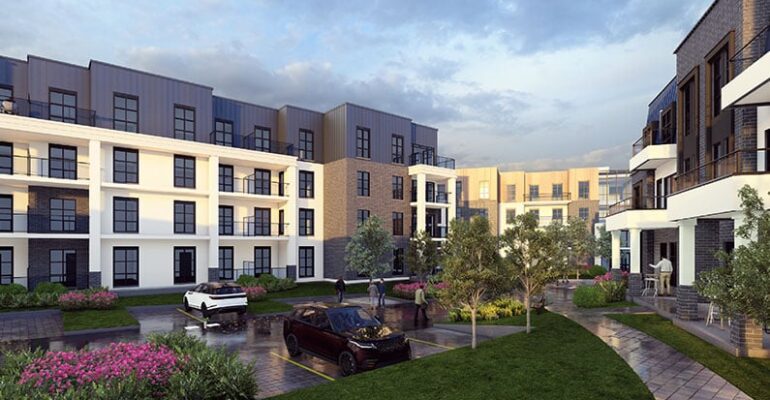Dean’s Landing at University District, Calgary

Location: Calgary, Alberta, Canada
Developer: Rohit Communities
Architect: NORR Architects
HGC was retained to conduct a noise feasibility study for a proposed multi-storey residential development now marketed as Dean’s Landing within the University District, located at 3921 32nd Avenue Northwest in Calgary, Alberta. The proposed development will consist of two blocks of four-storey residential condominiums along with seven townhouse buildings. The lands surrounding the proposed development are primarily existing residential and commercial land uses. The study was required by the City of Calgary as part of their planning and approvals process.
Primary Noise Sources
The primary noise sources impacting the site were determined to be future road traffic on 32 Avenue NW and on Shaganappi Trail NW. Road traffic data was obtained from the City of Calgary and was used to predict future traffic sound levels at the outdoor leisure areas around the proposed residential dwelling units. The predicted sound levels were compared to the sound level limits for designated truck routes provided in the City of Calgary Surface Transportation Noise Policy, TP003.Sound level predictions indicate that future road traffic sound levels in the outdoor leisure areas would not exceed the Design Noise Level criteria of 65 dBA. Therefore, no further sound attenuation was required at the proposed development based on the analysis.
Noise Level Criteria
Guidelines for acceptable levels of road traffic noise impacting residential developments are provided in the City of Calgary “Surface Transportation Noise Policy”. In this policy the Design Noise Level (DNL) is defined as “an amount of noise that is considered acceptable, and above which would be considered annoying”. For developments adjacent to a designated truck route, the DNL is an L10 limit of 65 dBA, where during a peak hour the noise level of 65 dBA is exceeded for 10% of the hour. Future traffic noise levels for truck routes are based on the higher of the 10 or 20 year forecasted volumes.
The term ‘Outdoor Leisure Area’ (“OLA”) is used in reference to an outdoor patio, a backyard, a common area allocated outside a multi-storey residential building, or other areas where passive recreation is expected to occur. The OLA also includes rear decks at the same elevation as the main floor for lots adjacent to a designated truck route.
Road Traffic Noise Prediction
To assess the levels of road traffic noise which will impact the site in the future, a predictive model was prepared and used to assess future sound levels. Prediction locations were chosen around the site to obtain appropriate representation of the future sound levels at the outdoor leisure areas.
Noise Feasibility Study Analysis and Conclusions
The assessment indicated that future traffic sound levels would be below the design noise level criteria for outdoor leisure areas. As a result, no further noise attenuation was required or recommended at the proposed development to address future traffic.
Acoustical Consulting Services Included:
- Land Use Noise Feasibility Study
- Road Traffic Noise Study
- Predictive Road Traffic Noise Modeling
